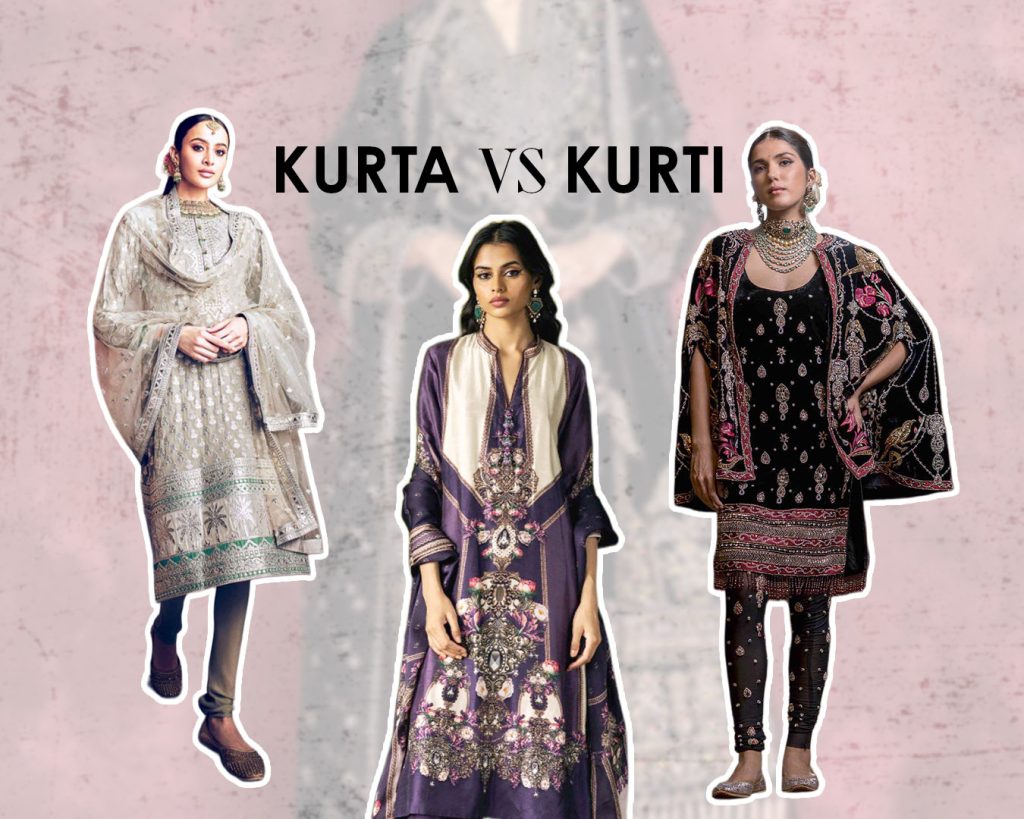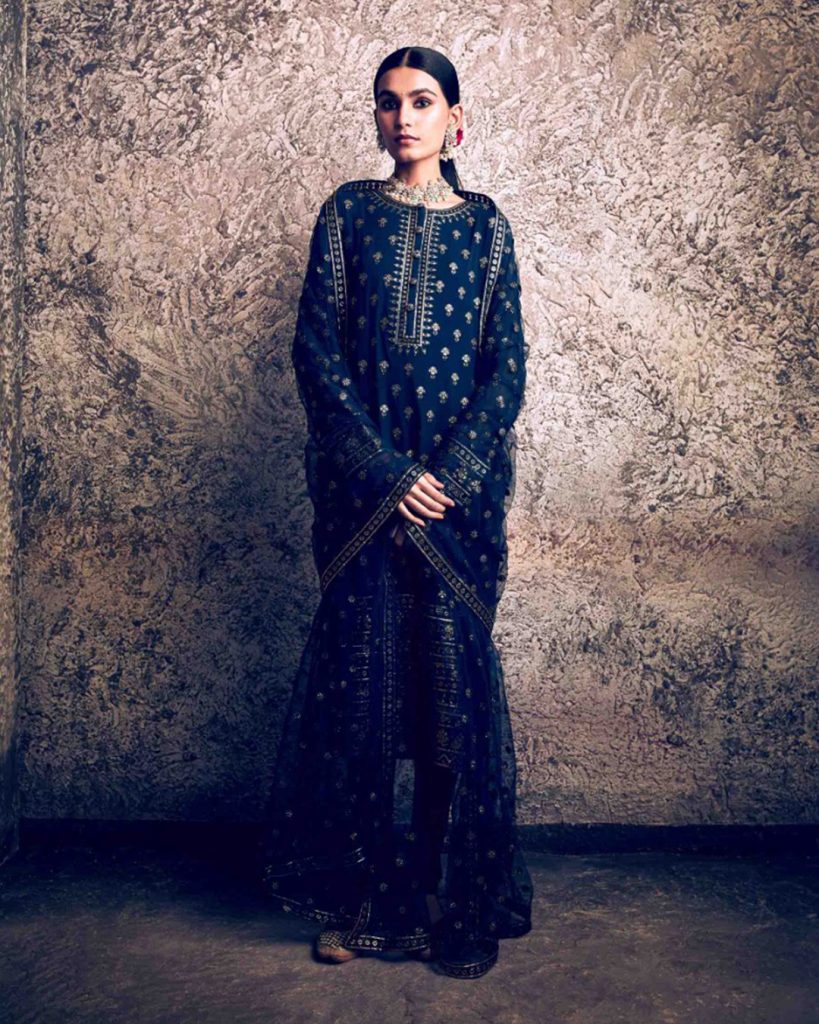
Kurtas and kurtis hold a special significance in the Indian culture and the wardrobes of Indian women. But more often than not, people are always confused between the two. Although visually similar, there are some key differences that distinguish the two. However, when discussing kurta vs. kurti, it is crucial to first understand both garments individually.
What is a Kurta?
A kurta is a loose-fitting, tunic-like traditional Indian attire worn by both men and women; however, men’s kurtas are a completely different garment. It is a versatile wardrobe staple that can be styled and worn for all sorts of occasions and settings.
These are often made from breathable and airy fabrics, making them a suitable choice for both casual and formal events. Depending on the occasion and personal preferences, it is worn with various bottoms to create unique kurta set combinations and looks.
- Key characteristics: It is a collarless, long, loose-fitting tunic, often made from airy fabrics, worn for casual as well as formal occasions. It can be a plain, printed, embellished or embroidered kurta set to match the occasion.
- Origin and evolution: The origin of the kurta can be traced back to Central Asian attire that became popular in South Asia during the early modern period. Over the period, it evolved into the current available iterations.
- Styling and occasions: For women, kurtas can be paired with churidars, palazzos, trousers, jeans, salwars, and even skirts to create a suitable look. Dupattas are also a popular element paired with kurtas to create a cohesive look.
What is a Kurti?
A kurti is the evolved version of the kurta that is shorter and fitted compared to the traditional kurta, often featuring a hip or mid-thigh length. It is a modern adaptation of the kurta, suitable for different occasions and settings, but it has a more casual feel to it. Kurtis, too, can be styled with various bottoms and accessories to create unique looks.
- Key characteristics: A kurti is significantly shorter than a kurta, usually ending at the hip or mid-thigh, and features a more fitted silhouette. The design of the kurti is rooted in culture but still offers a modern, chic look compared to the traditional kurta. These can be styled with different bottoms, such as churidars, trousers, jeans, salwars, and dhoti pants to achieve the desired look.
- Origins and evolution: Kurtis, too, are deeply rooted in the Indian cultural history but are a modern interpretation of the kurta. You can call them a contemporary version of the kurta, specifically meant for women.
- Styling options: Kurtis can be explored in different necklines and sleeve styles to achieve modern casual looks. Based on the occasion you are attending, you can choose the perfect kurti for yourself. Choose a simple, solid-hued kurti or a printed kurta set for everyday wear, while an embellished or embroidered kurti is the perfect pick for elaborate events and occasions.
H2: Kurta vs Kurti: Side-By-Side Comparison

| Point of Difference | Kurta | Kurti |
| Length and Fit | A kurta is loose-fitting and is longer, extending down the knee, sometimes up to the ankle. | A kurti features a fitted silhouette compared to a kurta and extends up to the hip or mid-thigh area. |
| Overall Structure and Silhouette | The kurta still maintains the originality of the structure, with a loose fit and long length. | A kurti features a more fitted and feminine silhouette, giving it a chic and contemporary look. |
| Fabric and Comfort | Kurtas are often made from lighter fabrics such as cotton, silk, and khadi, making them suitable for everyday wear and formal events. | Kurtis are made from a wide variety of fabrics, including chiffon, rayon, georgette, and linen for a stylish and feminine look. |
| Occasion and Fashion Relevance | Kurtas are more traditional and suitable for religious and formal events. For years, festive kurta sets have stayed fashionably relevant and a classic wardrobe staple. | Kurtis have a more casual vibe and are best styled for casual wear, office wear, parties or other special occasions. These also continue to be a wardrobe staple, serving modern fashion sensibilities. |
| Bottom Pairing | Kurtas are best paired with traditional bottoms, such as churidars, palazzos, salwars, etc. However, you can also pair them with jeans and trousers for a modern, contemporary look. | Kurtis are best paired with jeans, cigarette pants, skirts, and even shorts for a modern appeal. |
Conclusion
When it comes to choosing between a kurta and a kurti, the choice you make comes down to personal preferences. If you want to achieve a traditional and formal look, kurtas are the best pick. These are best paired with traditional bottoms such as churidars, salwars, palazzos and dhoti pants.
However, if you want a look that is more casual, young and feminine, a kurti is the ideal pick. Pair your favourite kurti with a pair of jeans, chinos or trousers for an elevated casual chic look.
Both are essential if you want to create a versatile, fashion-forward wardrobe that is occasion-appropriate, showcases your personal style and is comfortable to wear.
FAQ’s
What defines a kurta’s length?
The length of a kurta is defined by where the hem falls. Different lengths serve for different fashion preferences, occasions and settings. Typically, there are three length types for kurtas: short, medium and long.
- Short (Hip-length to mid-thigh): Short kurtas impart a casual and contemporary style that is popular among fashion-forward crowds and is best paired with jeans or chinos.
- Medium (Knee length to above the knee): This is the most versatile of them all when it comes to a kurta’s length. It is best when you want to strike the perfect balance between a traditional and casual look. This length of kurtas can also be styled with added accessories such as capes and jackets to create cape kurta sets for a unique look.
- Long (Below the knee to ankle length): Long kurtas are best if you want to achieve a traditional or formal look that is both elegant and timeless. This length is ideal for elaborate occasions such as weddings and festivals.
What is the main difference between a kurta and a kurti?
Some of the factors that differentiate a kurta and a kurti are the length, fit, bottom pairing, structure, fabric, comfort level, etc.
Can men wear a Kurti?
Men can wear kurtas for special occasions, but kurtis are meant for women only.
What are the common fabrics used for kurtis?
Some of the common fabrics used for making kurtis are cotton, rayon, silk, linen, georgette, chiffon, cotton and silk blends, khadi and muslin.